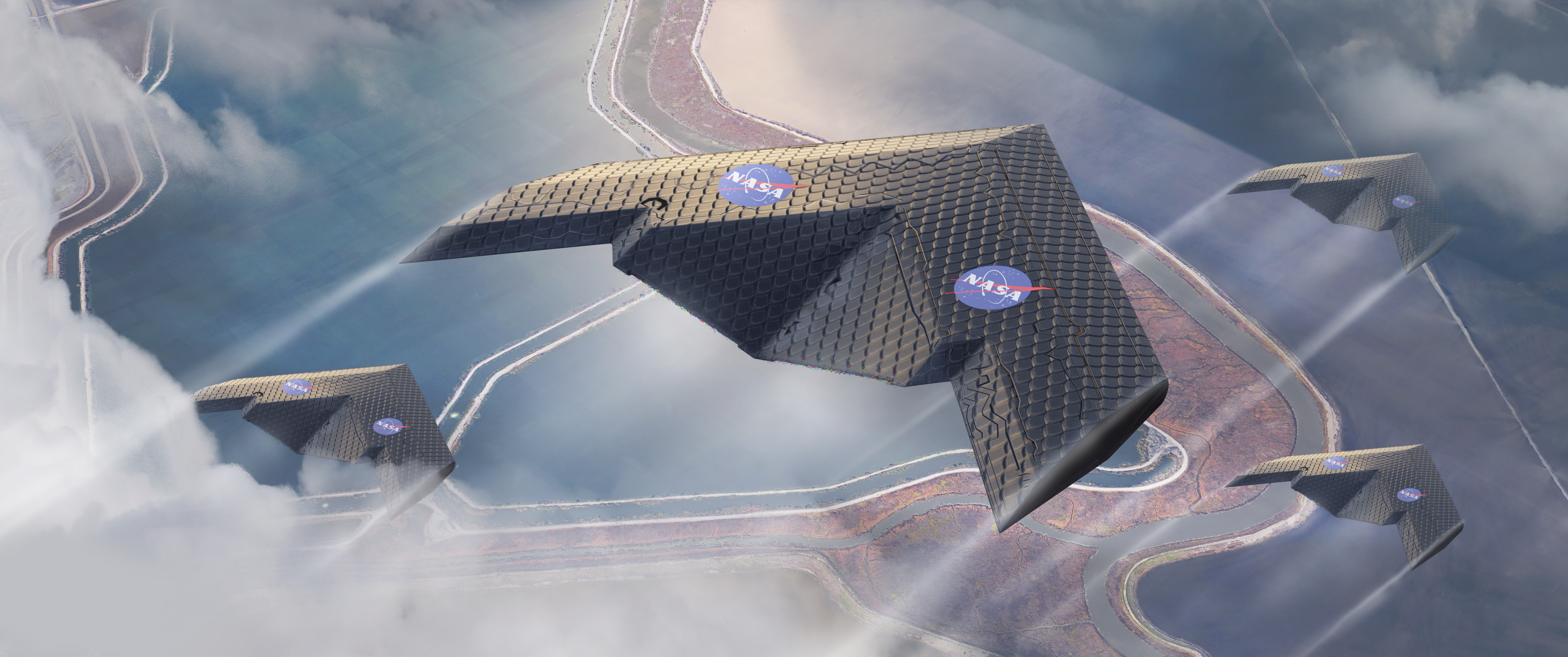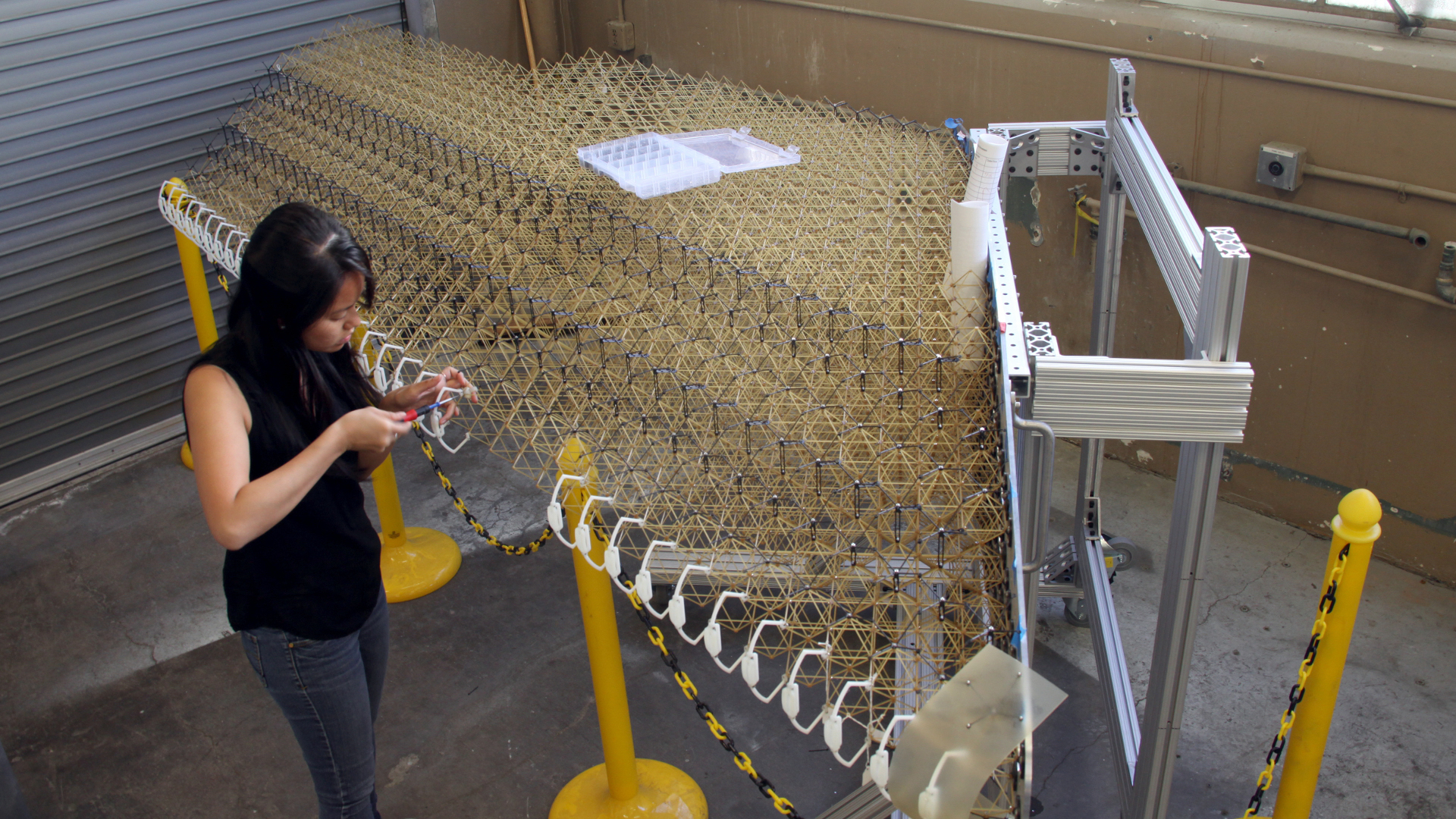MIT and NASA Take Flight With New Wing Structure
“Metamaterial” design aims for lighter, more energy-efficient aircraft that can be produced cost effectively.

New way of fabricating aircraft wings could enable radical new designs such as this concept. Image courtesy of Eli Gershenfeld, NASA Ames Research Center.
Latest News
August 19, 2019
Smart materials and structures promise to radically impact product development, from the design of buildings built to better withstand earthquakes and other disasters to airplane wings that can dynamically adjust to ensure optimal performance during flight.
A new partnership between MIT and NASA is taking aim at the latter challenge. A group of engineers have come up with a new airplane wing design as well as a new approach to wing construction that could enable lighter, more energy-efficient aircraft that could be produced cost effectively, according to researchers working on the project.
Described in a paper published in the Smart Materials and Structures journal, the new wing structure is comprised of hundreds of tiny identical subassemblies, which are bolted together in an open lattice framework and covered with a thin layer of polymer material. As the researchers describe it, the wing, made up of these thousands of tiny triangle lattice structures, consists mostly of empty space, which enables it to function as a mechanical “metamaterial” that combines the structural stiffness of a rubber-like polymer with the lightness and low-density of an aerogel.
The other key benefit of the duo’s design is that it’s deformable, meaning it can self-adjust to optimize aerodynamic performance depending on parameters like speed or weather or to account for the varying requirements for different phases of flight. Each phase—takeoff and landing, cruising, and maneuvering—lend themselves to optimal wing parameters, and a deformable design can be adjusted to the best configuration for each stage. Comparatively, a traditional wing design is a compromise as it’s not optimized for any particular stage of flight, according to Benjamin Jenett, a graduate student in MIT’s Center for Bits and Atoms, who was part of the project.
Conventional wings deploy separate moveable surfaces to control the roll and pitch of a plane for deformation. However, the research group’s proposed design pushes those boundaries via the new assembly system that allows for deformation of the whole wing or parts of it via the use of a combination of stiff and flexible components. In addition, instead of using motors and cables to create forces that would deform the wings, the MIT/NASA team has designed a system that automatically responds to changes in aerodynamic loading conditions via a shape-shifting or self-adjusting process.
“We’re able to gain efficiency by matching the shape to the loads at different angles of attack,” said Nicolas Cramer, a research engineer at NASA Ames and one of the lead authors on the report in a press release. “We’re able to produce the exact same behavior you would do actively, but we did it passively.” The wing was tested at NASA’s high-speed wind tunnel at Langley Research Center.
In parallel with the design, the research team focused on the manufacturing method. The first version of the wing was hand-assembled by graduate students, and the individual parts were cut using a waterjet system. As a result, it took several minutes to make each of those tiny individual components. In subsequent designs, the team created a much larger wing—about five times as big and close to the size of a wing for a single-seat plane—and used an injection molding process. This approach, while requiring an upfront investment in tooling, is better suited for scalable production levels at reasonable costs, the researchers claimed.

Longer-term, the team said the wing design could be assembled by simple, autonomous robots. In addition, the team said the same design and production approach could be used to accommodate wind turbine blades, space structures, bridges, and other high performance structures.
For more on the new wing design, watch this video clip.
Subscribe to our FREE magazine, FREE email newsletters or both!
Latest News
About the Author
Beth Stackpole is a contributing editor to Digital Engineering. Send e-mail about this article to DE-Editors@digitaleng.news.
Follow DERelated Topics






